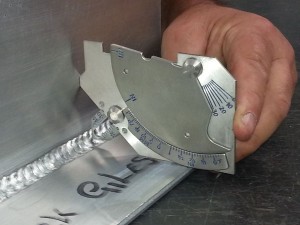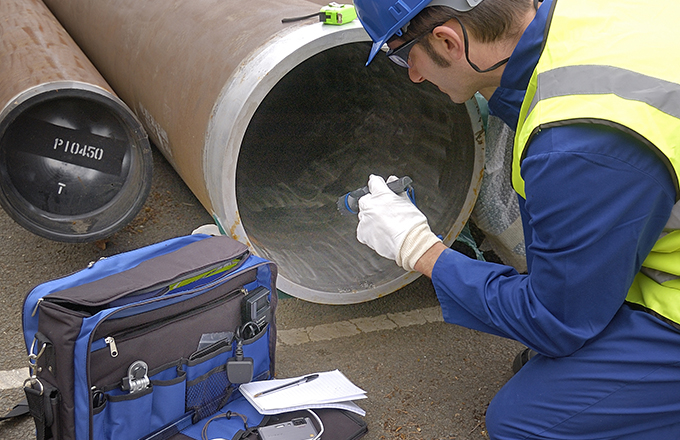A Detailed Checklist for Effective Welding Assessment Practices
In the realm of welding, the stability of structures is vital, requiring an extensive technique to examination methods. Checking out these critical parts can generate understandings that exceptionally influence welding operations.
Comprehending Welding Requirements
Welding standards play a vital duty in guaranteeing the high quality and safety and security of welded frameworks and elements. These criteria establish the criteria for materials, procedures, screening, and inspection, thereby giving a framework for consistent quality control in welding procedures. Different companies, including the American Welding Society (AWS), the International Organization for Standardization (ISO), and the American Culture of Mechanical Engineers (ASME), have created comprehensive requirements that govern different facets of welding.
Recognizing welding standards is necessary for experts in the field, as adherence to these guidelines lessens the risk of problems and failings in bonded joints. These criteria cover specific needs for weld quality, consisting of appropriate tolerances, the sort of welding strategies to be utilized, and the qualifications required for welders and inspectors.

Pre-Welding Examination Steps
Prior to any kind of welding procedure begins, a complete pre-welding inspection is important to identify prospective issues that might jeopardize the high quality of the weld. This first step functions as a vital structure for making sure conformity with relevant welding codes and standards.
The initial step in the pre-welding examination is to confirm the products being utilized. This consists of checking for the proper kind and grade of metals as specified in the project documents. Next off, it is essential to inspect the fit-up of the components to make sure correct alignment and joint configuration. Misalignment can lead to poor infiltration and structural weaknesses.
Additionally, evaluating the sanitation of the surface areas is vital; impurities such as paint, corrosion, or oil can adversely impact the top quality of the weld. Following this, an extensive evaluation of the welding devices need to be conducted, making sure that it is calibrated and in great functioning condition.
Finally, assessing the qualifications of the welding employees is important. Welders should possess the necessary accreditations and experience to perform the details welds required for the job. By sticking to these pre-welding examination steps, the likelihood of problems and failures in the final weld can be significantly reduced.

In-Process Evaluation Techniques
In-process evaluation methods play an important function in making certain the stability and quality of welds as they are being carried out. These techniques permit examiners to determine problems or variances from specifications in genuine time, thereby preventing pricey fixings and guaranteeing adherence to style requirements.
One trick strategy entails aesthetic evaluation, where examiners evaluate the weld bead for harmony, infiltration, and correct account. This can be enhanced by the use of gauges to measure weld dimensions, making sure conformity with predetermined resistances. In addition, the implementation of non-destructive testing (NDT) methods, such as ultrasonic screening or magnetic fragment screening, throughout the welding procedure can reveal subsurface defects that might not show up on the surface.
Another crucial aspect is keeping track of welding parameters, consisting of voltage, amperage, and travel rate. Consistency in these parameters is vital for accomplishing ideal weld top quality. Recording these parameters throughout the welding operation provides a deducible record for future recommendation.
Educating employees in correct inspection strategies and the use of proper devices boosts the effectiveness of in-process assessments. By incorporating these practices, companies can accomplish greater high quality welds, decrease rework, and inevitably ensure the security and reliability of bonded frameworks.
Post-Welding High Quality Checks
Adhering to the completion of welding procedures, post-welding top quality checks are crucial to confirm that the welds satisfy all defined standards and requirements. These checks are vital for ensuring the honesty and durability of the welded joints. The assessment procedure commonly begins with an aesthetic evaluation, analyzing for surface issues such as splits, porosity, or insufficient combination.
Subsequently, non-destructive screening (NDT) approaches, such as ultrasonic testing, radiographic screening, or magnetic fragment testing, might be employed to spot interior problems that are not noticeable to the naked eye. Each approach has its one-of-a-kind advantages and is picked based on the weld's area, material type, official source and the nature of the application.
In addition, verifying dimensional precision is a vital aspect of post-welding quality checks. This entails determining the weld's size, profile, and alignment to make certain compliance with engineering specs. Lastly, analyzing the mechanical residential properties of the weld, consisting of tensile toughness and ductility, can offer additional assurance of efficiency under operational problems. Generally, comprehensive post-welding evaluations are important for keeping security, performance, and adherence to regulative and market standards.
Documents and Reporting
Exactly how can efficient documentation and reporting improve the welding examination process? Precise documents and comprehensive coverage are important elements that ensure the integrity and top quality of welding operations. Welding Inspection Milwaukee. They serve as an official document of inspection searchings for, assisting in liability and traceability in conformity with sector requirements

A well-structured coverage system makes it possible for inspectors to this content clearly communicate any type of non-conformances, inconsistencies, or areas needing enhancement. This openness promotes a setting of continual improvement, as stakeholders can readily evaluate previous efficiency and implement rehabilitative actions.
Moreover, effective documents consists of detailed records such as welding treatment specs (WPS), welder credentials, and assessment lists. These aspects supply a framework for reviewing weld quality and adherence to established standards. In the occasion of conflicts or top quality concerns, comprehensive paperwork acts as a reputable referral, reducing uncertainty and shielding all events included.
Lastly, keeping organized documents helps in training and licensing workers, making sure that market best techniques are promoted. Eventually, precise documents and reporting not only enhance the welding inspection process however also contribute to the general security and integrity of bonded frameworks.

Final Thought
Finally, a detailed list for effective welding inspection techniques is crucial for making sure top quality and safety in bonded structures. Adherence to developed welding requirements, precise pre-welding inspections, strenuous in-process evaluations, and extensive post-welding top quality checks collectively add to the integrity of bonded joints. Furthermore, persistent documentation and coverage of evaluation searchings for improve responsibility and promote constant improvement. Applying these practices will substantially assist in compliance with market requirements and ultimately cultivate investigate this site a society of quality in welding procedures.
Welding criteria play a critical role in ensuring the quality and safety of bonded structures and components. Various organizations, consisting of the American Welding Society (AWS), the International Organization for Standardization (ISO), and the American Culture of Mechanical Engineers (ASME), have created comprehensive requirements that control various aspects of welding.
Following the completion of welding operations, post-welding high quality checks are vital to validate that the welds satisfy all specified requirements and needs - Welding Inspection Milwaukee.In conclusion, a thorough checklist for reliable welding inspection practices is important for guaranteeing quality and safety and security in welded structures. Adherence to developed welding requirements, precise pre-welding evaluations, rigorous in-process analyses, and detailed post-welding quality checks collectively contribute to the integrity of welded joints